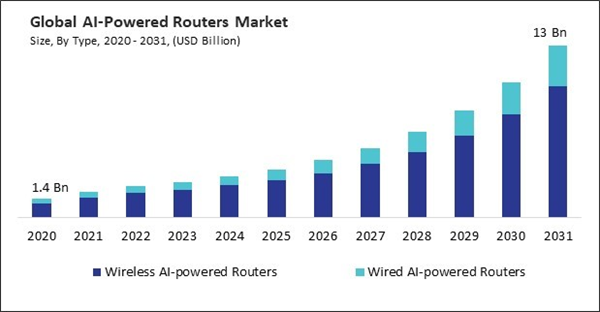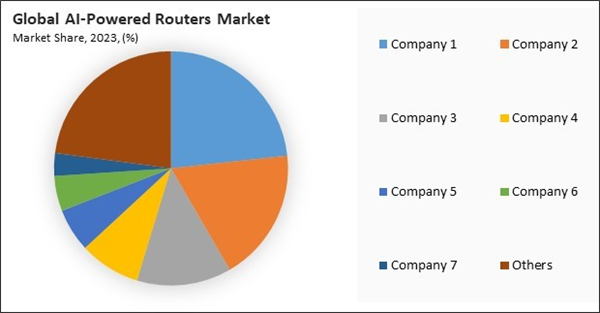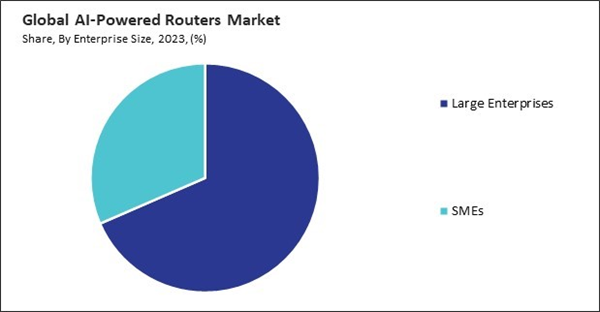The Global AI-Powered Routers Market is expected to reach $13 billion by 2031, rising at a market growth of 22.7% CAGR during the forecast period.
The increasing demand for robust and high-speed internet connectivity, particularly due to the rise of remote work and digital transformation initiatives, has propelled the adoption of AI-powered routers in North America. Thus, the North America segment acquired 37% revenue share in the AI-powered routers market in 2023. This supremacy can be due, in large part, to the region's highly developed technological infrastructure, the high adoption rates of modern technologies, and the presence of important players in the networking business.
As more households integrate smart technologies such as smart speakers, security cameras, thermostats, lighting systems, and kitchen appliances, the complexity and volume of data on home networks are growing. Each device requires seamless connectivity, low latency, and secure communications to function optimally. Additionally, the shift toward cloud-based services and the rise of remote work have transformed network demands, creating a growing need for more intelligent and efficient networking solutions. Traditional networking systems are frequently unable to accommodate the increase in data transmission as businesses increasingly depend on cloud computing and SaaS applications to store data and conduct critical operations. Therefore, such developments will aid in the expansion of the market.
However, AI-powered routers are typically more expensive than traditional models due to the integration of advanced technology, including artificial intelligence algorithms and enhanced features such as predictive analytics, automated network optimization, and self-healing capabilities. These technological advancements provide superior performance and efficiency but have a steep price tag. Hence, high initial costs remain a considerable barrier to the adoption of AI-powered routers.
The leading players in the market are competing with diverse innovative offerings to remain competitive in the market. The above illustration shows the percentage of revenue shared by some of the leading companies in the market. The leading players of the market are adopting various strategies in order to cater demand coming from the different industries. The key developmental strategies in the market are Acquisitions, and Partnerships & Collaborations.
The increasing demand for robust and high-speed internet connectivity, particularly due to the rise of remote work and digital transformation initiatives, has propelled the adoption of AI-powered routers in North America. Thus, the North America segment acquired 37% revenue share in the AI-powered routers market in 2023. This supremacy can be due, in large part, to the region's highly developed technological infrastructure, the high adoption rates of modern technologies, and the presence of important players in the networking business.
As more households integrate smart technologies such as smart speakers, security cameras, thermostats, lighting systems, and kitchen appliances, the complexity and volume of data on home networks are growing. Each device requires seamless connectivity, low latency, and secure communications to function optimally. Additionally, the shift toward cloud-based services and the rise of remote work have transformed network demands, creating a growing need for more intelligent and efficient networking solutions. Traditional networking systems are frequently unable to accommodate the increase in data transmission as businesses increasingly depend on cloud computing and SaaS applications to store data and conduct critical operations. Therefore, such developments will aid in the expansion of the market.
However, AI-powered routers are typically more expensive than traditional models due to the integration of advanced technology, including artificial intelligence algorithms and enhanced features such as predictive analytics, automated network optimization, and self-healing capabilities. These technological advancements provide superior performance and efficiency but have a steep price tag. Hence, high initial costs remain a considerable barrier to the adoption of AI-powered routers.
The leading players in the market are competing with diverse innovative offerings to remain competitive in the market. The above illustration shows the percentage of revenue shared by some of the leading companies in the market. The leading players of the market are adopting various strategies in order to cater demand coming from the different industries. The key developmental strategies in the market are Acquisitions, and Partnerships & Collaborations.
Driving and Restraining Factors
Drivers
- Rising adoption of smart homes and IoT
- Shift towards cloud-based services and remote work
- Rapid expansion of 5G networks
Restraints
- High initial costs of AI-powered routers
- Substantial data privacy concerns
Opportunities
- Growing investments in smart cities
- Rising need for self-healing networks
Challenges
- Complexity of implementing AI-powered routers
- Lack of standardization
Application Outlook
Based on application, the market is segmented into residential, enterprise, and industrial. The enterprise segment recorded 43% revenue share in the market in 2023. Enterprises increasingly rely on AI-powered routers to enhance network efficiency, manage large data traffic volumes, and provide secure connections for their employees and customers.Enterprise Size Outlook
On the basis of enterprise size, the market is bifurcated into large enterprises and SMEs. The SMEs segment procured 32% revenue share in the market in 2023. AI-powered routers provide these smaller businesses with features like automated troubleshooting, improved bandwidth management, and enhanced cybersecurity, which are often critical in environments with limited IT resources.Type Outlook
Based on type, the market is bifurcated into wireless AI-powered routers and wired AI-powered routers. The wireless AI-powered routers segment garnered 78% revenue share in 2023. This growth is owed to the growing demand for high-speed and flexible internet connectivity, which is notably evident as more users rely on remote work solutions and mobile devices.Wireless AI-powered routers Outlook
The wireless AI-powered routers segment is divided into single-band wireless AI-powered routers, dual-band wireless AI-powered routers, and tri-band wireless AI-powered routers. The single-band wireless AI-powered routers segment acquired 13% revenue share in the AI-powered routers market in 2023. The primary driving factor for this segment is its affordability and simplicity.End-use Outlook
On the basis of end use, the market is classified into IT & telecom, BFSI, education, healthcare, and others. The IT & telecom segment witnessed 37% revenue share in the market in 2023. This dominance can be attributed to the sector's increasing reliance on advanced networking solutions to support the growing demands for high-speed internet connectivity, data transfer, and enhanced network security.Deployment Outlook
By deployment mode, the market is divided into cloud-based and on-premises. The cloud-based segment procured 69% revenue share in the market in 2023. This expansion is because of the demand for scalable, adaptable networking solutions and the growing trend toward cloud computing.Regional Outlook
Region-wise, the market is analyzed across North America, Europe, Asia Pacific, and LAMEA. The Europe segment recorded 32% revenue share in the market in 2023. The European market is distinguished by a strong emphasis on innovation and the adoption of sophisticated technologies in a variety of sectors, such as telecommunications, industrial automation, and information technology.List of Key Companies Profiled
- Cisco Systems, Inc.
- Huawei Technologies Co., Ltd. (Huawei Investment & Holding Co., Ltd.)
- Juniper Networks, Inc.
- TP-Link Technologies Co. Ltd.
- Netgear, Inc.
- ASUSTeK Computer Inc.
- D-Link Corporation
- Belkin International, Inc. (Foxconn Interconnect Technology Limited)
- ZTE Corporation
- Arista Networks, Inc.
Market Report Segmentation
By Type
- Wireless AI-powered Routers
- Dual-band Wireless AI-powered Routers
- Single-band Wireless AI-powered Routers
- Tri-band Wireless AI-powered Routers
- Wired AI-powered Routers
By Enterprise Size
- Large Enterprises
- SMEs
By Deployment Mode
- Cloud-based
- On-premises
By Application
- Residential
- Enterprise
- Industrial
By End Use
- IT & Telecom
- BFSI
- Healthcare
- Education
- Others
By Geography
- North America
- US
- Canada
- Mexico
- Rest of North America
- Europe
- Germany
- UK
- France
- Russia
- Spain
- Italy
- Rest of Europe
- Asia Pacific
- China
- Japan
- India
- South Korea
- Singapore
- Malaysia
- Rest of Asia Pacific
- LAMEA
- Brazil
- Argentina
- UAE
- Saudi Arabia
- South Africa
- Nigeria
- Rest of LAMEA
Table of Contents
Chapter 1. Market Scope & Methodology
Chapter 2. Market at a Glance
Chapter 3. Market Overview
Chapter 4. Competition Analysis - Global
Chapter 5. Global AI-Powered Routers Market by Type
Chapter 6. Global AI-Powered Routers Market by Enterprise Size
Chapter 7. Global AI-Powered Routers Market by Deployment Mode
Chapter 8. Global AI-Powered Routers Market by Application
Chapter 9. Global AI-Powered Routers Market by End Use
Chapter 10. Global AI-Powered Routers Market by Region
Chapter 11. Company Profiles
Companies Mentioned
- Cisco Systems, Inc.
- Huawei Technologies Co., Ltd. (Huawei Investment & Holding Co., Ltd.)
- Juniper Networks, Inc.
- TP-Link Technologies Co. Ltd.
- Netgear, Inc.
- ASUSTeK Computer Inc.
- D-Link Corporation
- Belkin International, Inc. (Foxconn Interconnect Technology Limited)
- ZTE Corporation
- Arista Networks, Inc.
Methodology

LOADING...











